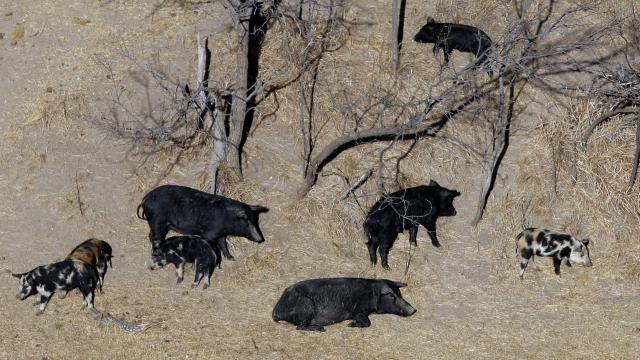Hey, it’s me, your local environmental reporter here to ruin all your feral hog fun.
Feral hog mania has swept the internet because, well, a random guy responded to a tweet about gun control by posing a “legit question for rural Americans” about how to kill the 30-50 feral hogs terrorising his kids. Guns are causing nightmares to come true, but our collective unravelling has somehow led to a place where people can’t stopping talking about feral hogs. And honestly, I’m here for it. I need to soothe my soul as much as the rest of you.
But I also need to inform you that the feral hog problem is no joke for most of the U.S.. The seedy underbelly of feral hogs goes much deeper than 30-50 pesky porkers rolling up on a playground. And as with all modern-day scourges, climate change will make the problem of wild boars worse.
The first thing you need to understand about feral hogs is that they’re an invasive species. They were introduced in present-day Florida way back in 1539 thanks to explorer Hernando de Soto. They slowly spread to other regions, but their populations remained largely stable for much of the 20th century in the 18-20 states they inhabited.
“After 1990s, all that changed,” Jack Mayer, a wild boar expert at Savannah River National Laboratory, told Gizmodo.
Hogs spread to 27 U.S. states by 2000 and are now found in 48 states, with Wyoming and Rhode Island the only states missing out on IRL feral hog mania. The big reason for their spread is because humans love to hunt them. Mayer said they’re the second-most hunted big game animal in the U.S. outside of white-tailed deer.
People took to releasing domesticated pigs into the wild where they proliferated and turned into suddenly huntable, memeable feral hogs. While you’re joking about the stages of feral hog Twitter or sharing whatever the hell this is, people in Texas are paying nearly $2000 to shoot hogs from helicopters. At the same time, the hogs are raising hell for farmers and conservationists by causing millions of dollars in crop damage and outcompeting native species, including some that are endangered. Laugh it up, folks!
The hogs have a few things going for their rapid proliferation. They love to bone, they become fertile at a young age, and they can produce up to two litters each year with up to half a dozen feral hoglets ready to go toe-to-toe with human children. They’re also “opportunistic omnivores,” or, as Mayer put it, “if there’s a calorie in it and they can get their mouth around it, they’ll eat anything.”
Mayer added that to control the unruly hog population, which he said runs anywhere from 6 million to 7 million, would require killing 60-80 per cent of the wild boars tearing across the U.S. countryside year after year until we got their numbers down to a manageable size or eradicated them completely.
That’s a tall task on its own, but rising temperatures have helped the hogs go into overdrive. Mayer noted the pigs are pretty adaptable and can flourish in environments as diverse as the Amazon and the Canadian prairies, but that “increased temperatures would help the species.” Specifically, rising winter temperatures in the U.S. and Canada mean that fewer of the hogs bite the dust and populations can further grow.
Europe — home to the OG feral hogs — is facing a hog takeover for similar reasons. If you think 30-50 feral hogs is a lot, you ain’t seen nothin’ yet.
